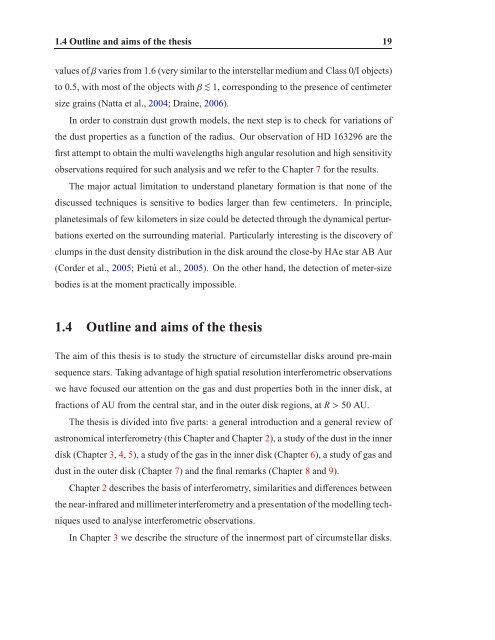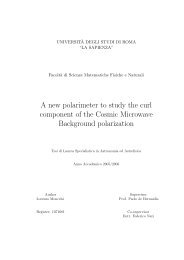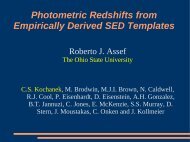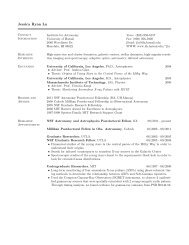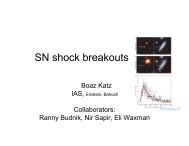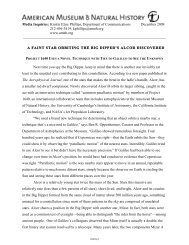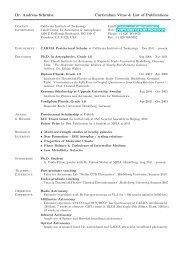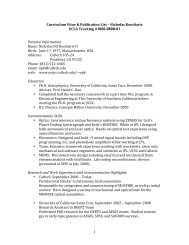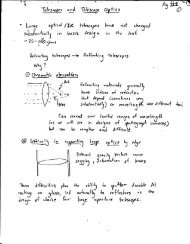Interferometric observations of pre-main sequence disks - Caltech ...
Interferometric observations of pre-main sequence disks - Caltech ...
Interferometric observations of pre-main sequence disks - Caltech ...
You also want an ePaper? Increase the reach of your titles
YUMPU automatically turns print PDFs into web optimized ePapers that Google loves.
1.4 Outline and aims <strong>of</strong> the thesis 19<br />
values <strong>of</strong>βvaries from 1.6 (very similar to the interstellar medium and Class 0/I objects)<br />
to 0.5, with most <strong>of</strong> the objects withβ< ∼ 1, corresponding to the <strong>pre</strong>sence <strong>of</strong> centimeter<br />
size grains (Natta et al., 2004; Draine, 2006).<br />
In order to constrain dust growth models, the next step is to check for variations <strong>of</strong><br />
the dust properties as a function <strong>of</strong> the radius. Our observation <strong>of</strong> HD 163296 are the<br />
first attempt to obtain the multi wavelengths high angular resolution and high sensitivity<br />
<strong>observations</strong> required for such analysis and we refer to the Chapter 7 for the results.<br />
The major actual limitation to understand planetary formation is that none <strong>of</strong> the<br />
discussed techniques is sensitive to bodies larger than few centimeters. In principle,<br />
planetesimals <strong>of</strong> few kilometers in size could be detected through the dynamical pertur-<br />
bations exerted on the surrounding material. Particularly interesting is the discovery <strong>of</strong><br />
clumps in the dust density distribution in the disk around the close-by HAe star AB Aur<br />
(Corder et al., 2005; Pietú et al., 2005). On the other hand, the detection <strong>of</strong> meter-size<br />
bodies is at the moment practically impossible.<br />
1.4 Outline and aims <strong>of</strong> the thesis<br />
The aim <strong>of</strong> this thesis is to study the structure <strong>of</strong> circumstellar <strong>disks</strong> around <strong>pre</strong>-<strong>main</strong><br />
<strong>sequence</strong> stars. Taking advantage <strong>of</strong> high spatial resolution interferometric <strong>observations</strong><br />
we have focused our attention on the gas and dust properties both in the inner disk, at<br />
fractions <strong>of</strong> AU from the central star, and in the outer disk regions, at R>50 AU.<br />
The thesis is divided into five parts: a general introduction and a general review <strong>of</strong><br />
astronomical interferometry (this Chapter and Chapter 2), a study <strong>of</strong> the dust in the inner<br />
disk (Chapter 3, 4, 5), a study <strong>of</strong> the gas in the inner disk (Chapter 6), a study <strong>of</strong> gas and<br />
dust in the outer disk (Chapter 7) and the final remarks (Chapter 8 and 9).<br />
Chapter 2 describes the basis <strong>of</strong> interferometry, similarities and differences between<br />
the near-infrared and millimeter interferometry and a <strong>pre</strong>sentation <strong>of</strong> the modelling tech-<br />
niques used to analyse interferometric <strong>observations</strong>.<br />
In Chapter 3 we describe the structure <strong>of</strong> the innermost part <strong>of</strong> circumstellar <strong>disks</strong>.


